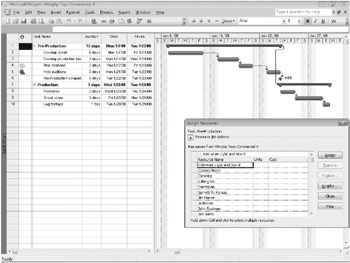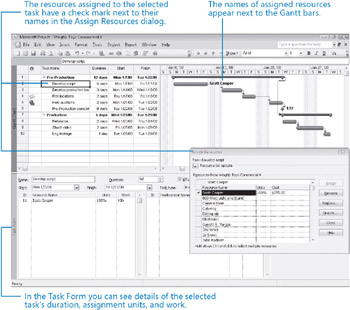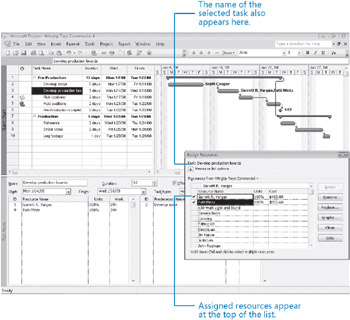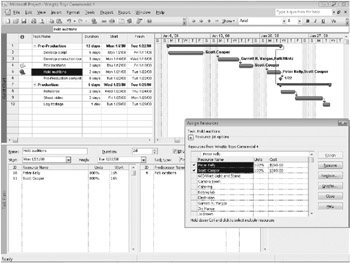Assigning Work Resources to Tasks
Assigning a work resource to a task enables you to track the progress of the resource’s work on the task. If you enter resource pay rates, Project also calculates resource and task costs for you.
You might recall from Chapter 3 that the capacity of a resource to work is measured in units (a level of effort measurement), and recorded in the Max. Units field. Unless you specify otherwise, Project assigns 100% of the units for the resource to the task-that is, Project assumes that all of the resource’s work time can be allotted to the task. If the resource has less than 100% maximum units, Project assigns the resource’s Max. Units value.
In this exercise, you make the initial resource assignments to tasks in the project plan.
Be Sure To start Microsoft Office Project 2007 if it’s not already running.
| Important | If you are running Project Professional, you may need to make a one-time adjustment to use the Computer account and to work offline. This ensures that the practice files you work with in this chapter do not affect your Project Server data. For more information, see “Starting Project Professional” on page 11. |
Open Wingtip Toys Commercial 4a from the \Documents\Microsoft Press\Project 2007 SBS\Chapter 4 Simple Assignments folder. You can also access the practice files for this book by clicking Start, All Programs, Microsoft Press, Project 2007 Step by Step, and then selecting the chapter folder of the file you want to open.
1. On the File menu, click Save As.
The Save As dialog box appears.
2. In the File name box, type Wingtip Toys Commercial 4, and then click Save.
3. On the Tools menu, click Assign Resources.
| Tip | You can also click the Assign Resources button on the Standard toolbar. |
The Assign Resources dialog box appears, in which you see the resource names you entered in Chapter 3, plus additional resources. Except for assigned resources, which always appear at the top of the list, resources are sorted alphabetically in the Assign Resources dialog box.

| Tip | If you are using Project Professional, you also see the R/D (request or demand) column in the Assign Resources dialog box. This relates to setting a priority for a resource assignment when using a Project Server feature called Resource Substitution. For more information about Project Server in general, see Part 4, “Introducing Project Server.” |
4. In the Task Name column, click task 2, Develop script.
5. In the Resource Name column in the Assign Resources dialog box, click Scott Cooper, and then click the Assign button.
A cost value and check mark appears next to Scott’s name, indicating that you have assigned him to the task of developing the script. Because Scott has a cost standard rate recorded, Project calculates the cost of the assignment (Scott’s standard pay rate times his scheduled amount of work on the task) and displays that value, $775, in the Cost field of the Assign Resources dialog box.
Next, you’ll take a closer look at the scheduling values affecting task 2. You’ll use a handy view called the Task Form.
6. On the Window menu, click Split.
Project splits the window into two panes. In the upper pane is the Gantt Chart view, and below it is the Task Form.

In the Task Form, you can see the essential scheduling values for this task: five days’ duration, 40 hours of work, and 100% assignment units. Because the Task Form is a handy way to see a task’s duration, units, and work values, you’ll leave it displayed for now.
Next, you assign two resources simultaneously to a task.
7. In the Task Name column, click task 3, Develop production boards.
8. In the Assign Resources dialog box, click Garrett R.Vargas, hold down the ![]() key to make a nonadjacent selection, click Patti Mintz, and then click Assign.
key to make a nonadjacent selection, click Patti Mintz, and then click Assign.
Check marks appear next to Garrett’s and Patti’s names and their assignment costs are calculated, indicating that you have assigned both to task 3. You can also see the resulting assignment information (units and work per resource) and the task’s duration in the Task Form.

| Troubleshooting | If you should accidentally assign only a single resource when you intended to assign multiple resources, you can undo the assignment. On the Edit menu, click Undo Assignment. |
To conclude this exercise, you will make initial resource assignments for the remaining pre-production tasks.
9. In the Task Name column, click the name of task 4, Pick locations.
10. In the Assign Resources dialog box, click Scott Cooper, and then click Assign.
A check mark and cost value appear next to Scott’s name, indicating that you have assigned him to task 4.
| Tip | To remove or unassign a resource from a selected task, in the Assign Resources dialog box, click the resource name, and then click the Remove button. |
11. In the Task Name column, click the name of task 5, Hold auditions.
12. In the Assign Resources dialog box, click Peter Kelly, hold down the ![]() key, click Scott Cooper, and then click Assign.
key, click Scott Cooper, and then click Assign.
Check marks and cost values appear next to Peter’s and Scott’s names, indicating that you have assigned both to task 5.

After you create a task but before you assign a resource to it, the task has duration but no work associated with it. Why no work? Work represents the amount of effort a resource or resources will spend to complete a task. For example, if you have one person working full-time, the amount of time measured as work is the same as the amount of time measured as duration. In general, the amount of work will match the duration unless you assign more than one resource to a task or the one resource you assign is not working full-time.
Project calculates work using what is sometimes called the scheduling formula:
![]()
Let’s look at a specific example. The duration of task 2 is five days. For our TV commercial project, five days equals 40 hours. When you assigned Scott Cooper to task 2, Project applied 100% of Scott’s working time to this task. The scheduling formula for task 2 looks like this:
![]()
In other words, with Scott assigned to task 2 at 100% units, the task should require 40 hours of work.
Here’s a more complex example. You assigned two resources to task 5, each at 100% assignment units. The scheduling formula for task 5 looks like this:
![]()
The 32 hours of work is the sum of Peter’s 16 hours of work plus Scott’s 16 hours of work. In other words, both resources will work on the task in parallel.
EAN: 2147483647
Pages: 247